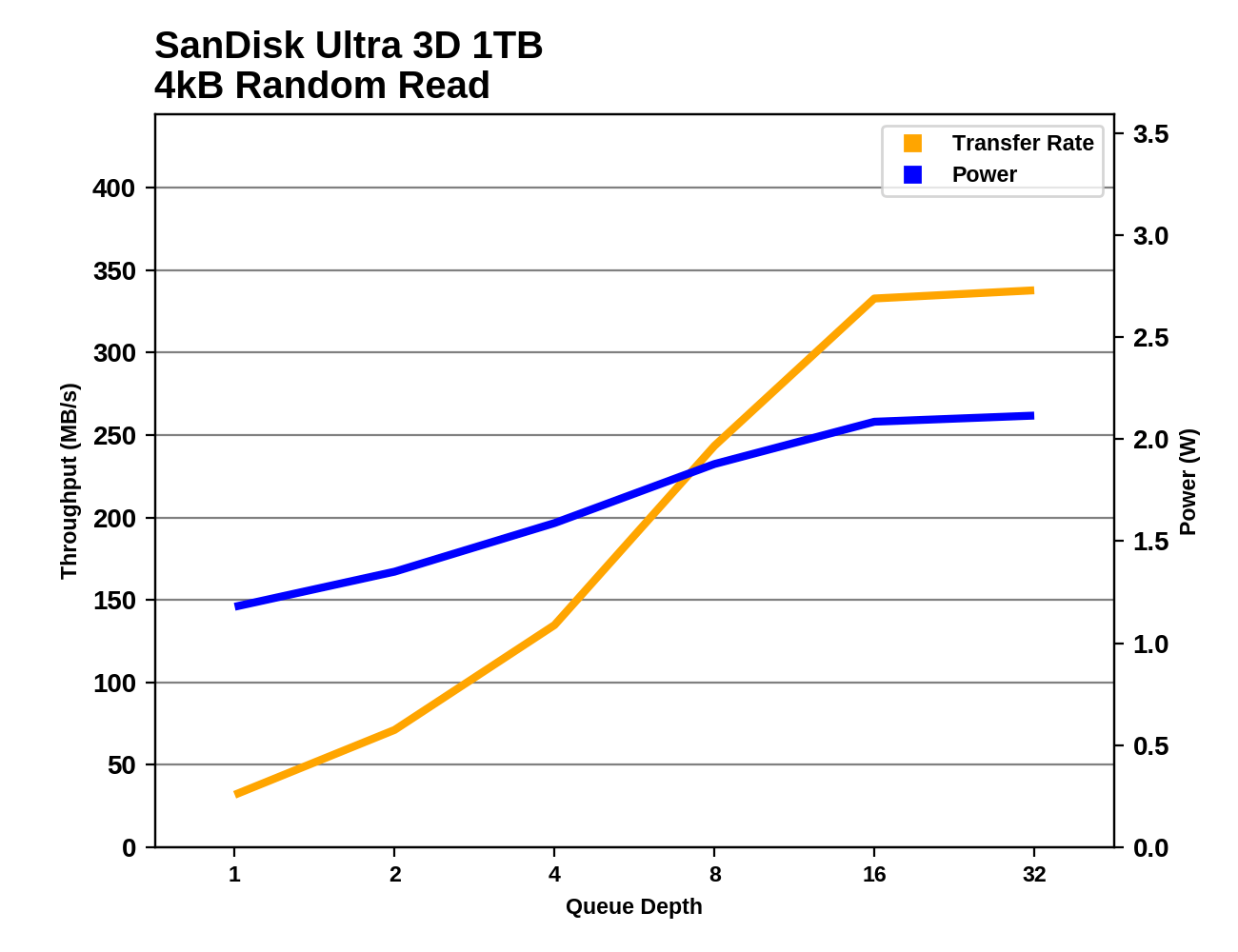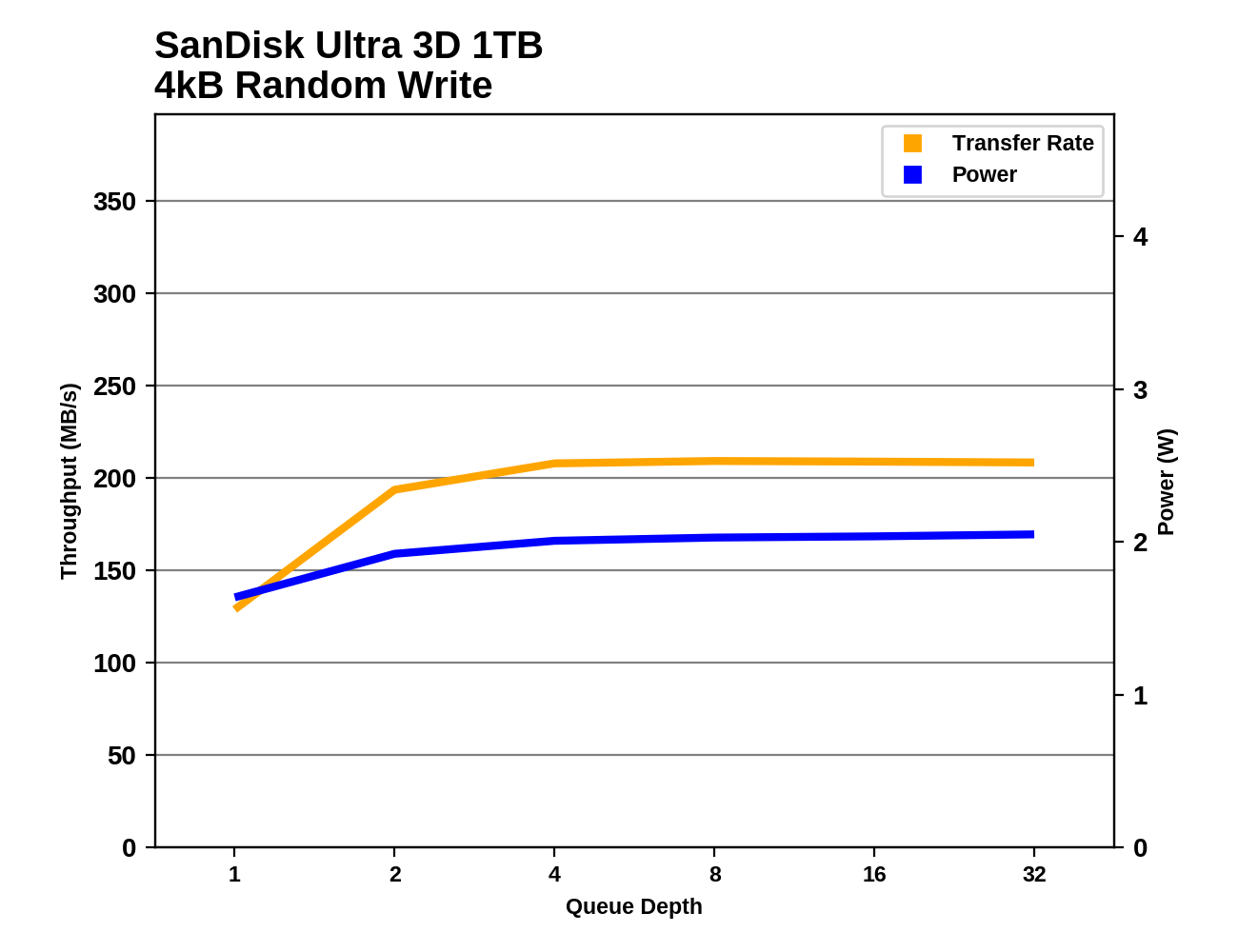One Design, Two Products: The SanDisk Ultra 3D (1TB) and WD Blue 3D (1TB) SSD Reviews, with BiCS 3D NAND
by Billy Tallis on September 14, 2017 9:00 AM ESTRandom Read Performance
Our first test of random read performance uses very short bursts of operations issued one at a time with no queuing. The drives are given enough idle time between bursts to yield an overall duty cycle of 20%, so thermal throttling is impossible. Each burst consists of a total of 32MB of 4kB random reads, from a 16GB span of the disk. The total data read is 1GB.

Orange is for the new drives, Blue is for the previous generation models
The switch to 3D NAND gives a clear boost to the random read performance of Western Digital's SSDs. The WD Blue was already in second place, but it has now narrowed the Samsung 850 PRO's lead.
Our sustained random read performance is similar to the random read test from our 2015 test suite: queue depths from 1 to 32 are tested, and the average performance and power efficiency across QD1, QD2 and QD4 are reported as the primary scores. Each queue depth is tested for one minute or 32GB of data transferred, whichever is shorter. After each queue depth is tested, the drive is given up to one minute to cool off so that the higher queue depths are unlikely to be affected by accumulated heat build-up. The individual read operations are again 4kB, and cover a 64GB span of the drive.

The performance boost from 3D NAND doesn't disappear on the longer random read test: the new Western Digital SSDs are able to hold on to second place, this time much closer to the Samsung 850 PRO in performance.

The WD/SanDisk drives already had great power efficiency for random reads, but the 3D NAND improves it even more. The Intel 545s still has the clear lead, but it isn't such a wide margin anymore.
 |
|||||||||
The performance scaling behavior of the SanDisk Ultra 3D and WD Blue 3D NAND are quite similar to other top-performing drives, with performance mostly saturated by QD16. The power consumption is much lower and scales more gradually than on Samsung's drives.
Random Write Performance
Our test of random write burst performance is structured similarly to the random read burst test, but each burst is only 4MB and the total test length is 128MB. The 4kB random write operations are distributed over a 16GB span of the drive, and the operations are issued one at a time with no queuing.

The older WD/SanDisk drives had some trouble with QD1 burst random write performance, but the new 3D NAND drives are as fast as any other TLC SATA SSDs on this test, and not too far behind the 3D MLC drives.
As with the sustained random read test, our sustained 4kB random write test runs for up to one minute or 32GB per queue depth, covering a 64GB span of the drive and giving the drive up to 1 minute of idle time between queue depths to allow for write caches to be flushed and for the drive to cool down.

On the longer test that brings in higher queue depths, the WD and SanDisk drives still fare poorly even with 3D NAND. Toshiba manages to deliver a better score with their OCZ Trion 150 using 15nm planar TLC, even though the Trion 150 was in last place for QD1 random write performance.

In spite of poor performance, the WD and SanDisk 3D NAND drives have good power efficiency that is on par with Samsung, but behind the Intel and Micron 3D NAND SSDs.
 |
|||||||||
Most of these SSDs reach their full random write performance by QD4 and don't gain anything from higher queue depths. The WD Blue 3D NAND and SanDisk Ultra 3D fit this description too, but with a remarkably sub-par performance at saturation.










52 Comments
View All Comments
Foeketijn - Thursday, September 14, 2017 - link
We are talking about a Watt. Difference or so. Adding an extra fan has more impact. (Laptop? Who is upgrading a laptop with an 2,5" disk? Those are only found in really cheap devices anyway) The evo is known to just keep on going way way over that endurance point. How will these fare? We don't know yet. I think he has a fair point. There is no logical reason to choose this over a samsung other than not liking samsung. And samsung is just sitting there waiting till people notice their m2 driver are creaping to their sata prices. For a couple dollar more you get benchmarks that don't fit in these diagrams. I'm not a samsung fan. Just sad that no one is even trying to win this fight. The 850 evo is almost 3 years old and still on top for it's pricepoint (250Gb it is)mapesdhs - Thursday, September 14, 2017 - link
Indeed, so until I see tech akin to the 850 EVO come back down to the 55 UKP level for 250GB where it was at a couple of years ago, I just keep hunting for new or lighly used 840 Pro or other models via normal auction, bagged another 840 Pro 256GB recently for 51 UKP; would be fascinating to see how this model and others from previous generations of good SSDs would fare in these tests (Vertex4, Neutron GTX, Extreme Pro, Vector, etc.) Except for power consumption (who cares in a desktop), I doubt the latest models are that much better at all. I miss the days of buying an 850 EVO 500GB for 118 UKP (that was Oct/2015).Until then, there's better value in NVMe models with addin card adapters, eg. SM951.
Luckz - Wednesday, October 11, 2017 - link
When talking pound prices, it might be reasonable to mention how much your currency has changed since the 840 came out.Rictorhell - Thursday, September 14, 2017 - link
Hoping for someone, other than Samsung, to come up with a viable and somewhat affordable 4tb ssd, sata, or otherwise, so that prices at or near that capacity will become at least somewhat reasonable, someday, for those of us that need/want that capacity in an ssd.MajGenRelativity - Thursday, September 14, 2017 - link
That would be nice, but for now, you could just buy two SSDs and RAID them together?mapesdhs - Thursday, September 14, 2017 - link
That's one heck of a reliability risk.MajGenRelativity - Friday, September 15, 2017 - link
Depending on the RAID type, your reliability risk would be the same, or better. Could be worse, but that would be if you were doing a striped volume, which only increases performance, and I don't think OP was looking for thatCheapSushi - Sunday, September 17, 2017 - link
Yeah, so is having 1 PSU, no redundant power from difference sources, so is not having ECC RAM usually because anyone that does something with their computer is looking for six nines in uptime because they're obviously a datacenter...TheinsanegamerN - Sunday, September 17, 2017 - link
So is keeping 4TB of data on a single drive that can fail without warning.BrokenCrayons - Thursday, September 14, 2017 - link
Nice drives for a reasonable price and finally Samsung is starting to see a few competitive products but I don't think the focus is on SATA SSDs at this point. They're commonplace, but because the drive interface is limiting performance, we're unlikely to see any further high performance storage products for SATA which may explain why Samsung's not fighting very hard to keep a top tier drive there. They need mainstream and/or cost-effective storage which are essentially what SanDisk/WD, Crucial, and every other company that sells SATA SSDs ships out now. There's nothing wrong with that situation. I'm still on SATA and perfectly happy with the product selection out there now, but there's not much envelope left to push without shifting to interfaces like NVMe.